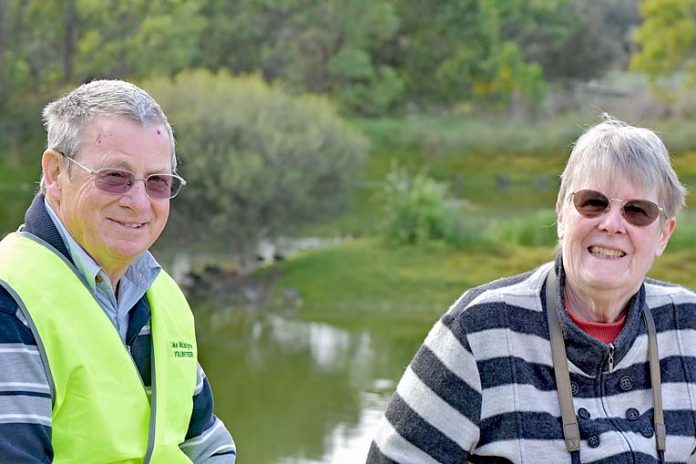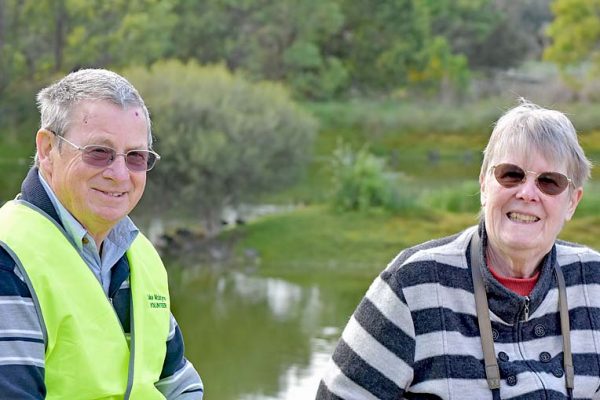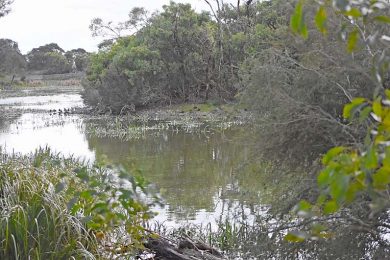

LAKE McIntyre has been flourishing due to the tireless work of Noel and Sheila Boyle, the lake committee, Wattle Range Council and the hundreds of kindergarten and school students who have planted trees around the lake’s perimeter.
“The idea is that if a child plants a tree here, they will be less likely to muck around near the lake,” Noel Boyle said on a guided tour of the lake’s walking trail.
The Boyles have a long history with Lake McIntyre, with their son Adrian originally a committee member before Sheila became involved in the lake’s activities through birdwatching.
Noel then came on board and while Adrian left the region, the Boyles have stayed on as the lake’s volunteer caretakers.
Adrian originally discovered the 20-year-old Masked Lapwing and Sheila points out near the entrance where the bird, believed to be one of the world’s oldest according to the Australian Bird and Bat Banding Scheme, was tagged all those years ago.
“Of course, it would have just been a little ball of fluff then,” she said.
Lake McIntyre is named after the McIntyre family, which the Millicent District Council (now Wattle Range Council) purchased land from in 1975.
Originally used for saleyards and a quarry, then-councillor Trevor Osborne had the foresight to turn the quarry area into a man-made lake.
In 1991, former councillor Ian Dunnicliff built on the project, transforming the lake into a conservation site for birds, reptiles and mammals.
This information can be found in the interpretive centre, just a little way past the barbecue areas that were made possible by the Millicent Lionesses and Lions.
The immaculate lawns are kept trimmed thanks to a couple who donated a ride-on lawnmower to the Lake McIntyre committee.
People visit the lake for reasons both simple and ornate, the Boyles explain, before setting off on the trail.

Visitors range from people who just want to jog laps around the lake, to brides and grooms for weddings.
Then of course, there are people like the Boyles, who simply enjoy observing the wildlife.
On the tour when they are not pointing out which trees children have planted, or projects such as the Early Learning Centre’s Butterfly Ridge, they keep a keen eye on the numerous species which inhabit the park.
“We’re currently doing a survey on Latham’s Snipe, or the Japanese Snipe,” Sheila explained.
“This is one of the world’s most significant sites for the snipe and they come in August and leave around March.
At the moment we have Speckled Duck, we used to have around 465 and now we’re down to around 200.”
Noel said the Speckled Duck is nocturnal, limiting it’s chance of survival.
While the Boyles have taken measures to ensure nothing can harm the wildlife within the confines of the lake, it is a different matter outside the fences.
The measures taken by the lake committee and council to ensure a safe habitat include a strict no dogs policy and no bins, as the rubbish attracts feral cats and dogs and vermin.
Any rubbish that enters the lake has to leave the lake.
Seats have been created for those who have trouble walking great distances and the Boyles are always conscious of how wheelchair accessible the trail is.
Observation hides and the boardwalk have been improved for safety, with the Millicent Community Learning Centre building stairs to the observation hide near the frog hollow.
Noel said the surrounds have also been altered to suit the animals.
“We do not touch that because it’s for the lizards and insects and spiders to hide in,” he said.
Later down the trail he indicated swamp rats had been near some crushed eggshell and low marshland serves a purpose in guiding birds to the lake.
“Birds will not actually visit a body of water unless they see they have somewhere to land and take off,” Sheila said.
The Boyles credit the flourishing life of the lake to the volunteers past and present, with some, like Bob Downs and Brian Foster, having sites dedicated to them in Downs Island and Foster’s Hill respectively.
The latest plantings come from the McArthur Park Kindergarten.









